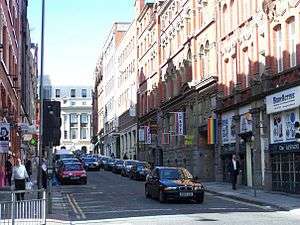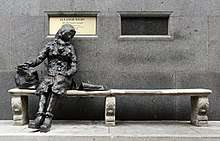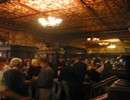Stanley Street, Liverpool
Stanley Street, in the centre of Liverpool, England, runs south between Dale Street and Whitechapel. As well as being home to numerous businesses ranging from estate agents to solicitors, some residents live in apartments in upper floors of some of the buildings. As part of the Big Dig, the southern half of the street between Whitechapel and Victoria Street was repaved in 2007, and is used as a taxi-rank serving Liverpool's central shopping district.

History
There are several Grade II Listed buildings in Stanley Street (see Listed buildings in Liverpool), due to their local historical importance. Many of the buildings are former warehouses, and are testament to Liverpool's industrial past. Stanley Street was also the location for Liverpool's first synagogue,[1] in existence in the 1750s. The synagogue no longer stands, but a special commemorative plaque was unveiled in 2008 in Whitechapel, close to the original spot of the synagogue.[2]
The Beatles

Stanley Street also gains considerable interest from Beatles fans, due to its close proximity to Mathew Street and the Cavern Quarter (home of The Cavern Club), and is the location of the statue of Eleanor Rigby, designed by London musician and artist Tommy Steele. The statue is dedicated to "All the lonely people", and was donated to the City of Liverpool in 1982 as a tribute to The Beatles. A hotel called 'The Eleanor Rigby Hotel' is also located here.[3]
At the time when The Beatles were performing in Liverpool, Stanley Street was the site of Hessy's Music store, one of the city's biggest music retailers. It was here that Mimi Smith (John Lennon's aunt), bought Lennon his first guitar in 1957.[4] The street has also been home to an independent radio station, Radio City.
Local LGBT Community
Stanley Street is also very much a focal point for Liverpool's LGBT community and is home to a cluster of gay bars and clubs between Dale St and Victoria Street. Stanley Street is the most recognised and referenced street in the Stanley Street Quarter.

In response to campaigns from members of Liverpool's LGBT community, including Councillor Steve Radford, of Liverpool-based Liberal Party (UK, 1989),[5] Liverpool City Council, has approved the partial pedestrianisation of Stanley Street,[6] between Victoria Street and Dale Street. With the use of rising automatic hydraulic bollards from 10pm-6am every night, it is hoped the scheme will enhance the night time leisure experience of the Stanley Street Quarter. Many in Liverpool's LGBT community hope that Stanley Street could eventually become popular destination for the LGBT Community - perhaps Liverpool's answer to Canal Street (Manchester), home to Manchester's Gay Village. A report for Liverpool City Council in 2011 suggested the possibility of earlier closure of Stanley Street, from 6pm onwards each day.[7]
The longest established gay venue on the corner of Stanley Street/Victoria Street is 'The Lisbon', housed in a Grade II listed building, just below street level. Its unique ceiling is arguably its most admirable feature, and is often the first thing people notice when inside. The other bars on Stanley Street tend to be newer additions to the gay scene.
References
- Liverpool Old Hebrew Congregation, Liverpool Record Office, Ref: 296 OHC
- Jones, Catherine (8 July 2008). "Metquarter plaque tribute to city's first synagogue".
- "The Eleanor Rigby Hotel". www.theeleanorrigbyhotel.com. Archived from the original on 29 January 2014.
- Harry, B. (1992) The ultimate Beatles encyclopedia. London: Virgin Books. p. 618
- "News: Liverpool and Merseyside news - Liverpool Echo". icliverpool.icnetwork.co.uk.
- "Progress for Liverpool's gay village - PinkNews · PinkNews". www.pinknews.co.uk. Retrieved 12 June 2019.
- "Wayback Machine" (PDF). 27 March 2012. Archived from the original (PDF) on 27 March 2012. Retrieved 12 June 2019.